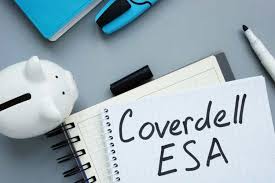Coverdell Education Savings Accounts (Coverdell ESA) are trusts set up to pay the college expenses of a beneficiary. They involve two parties: a custodian, who manages the account, and a beneficiary, who receives distributions from the account. The parties are usually a parent and their child, although a grandparent or other person may set up a Coverdell ESA for a child.
The custodian establishes and controls the assets in the Coverdell account for the beneficiary, who must be under the age of 18. All assets in a Coverdell must be distributed to the beneficiary before he or she turns 30 years old. However, the custodian may name a new beneficiary for the account if he wishes to preserve the account for another child.
Coverdell ESA’s may be self-directed investment accounts. They may hold cash and CD’s as well as securities such as stocks, bonds, and mutual funds. The value of the assets may rise and fall with the respective values of the securities in it. They are normally set up so that the custodian can select from a wide range of securities.
Contributions
Contributions to a Coverdell must be made in cash and they are not tax deductible. Any individual whose modified adjusted gross income is under the limit set for a given tax year can make a contribution of up to $2,000. The limit for 2022 is $220,000 for a married couple and $110,000 for single filers.
Organizations such as corporations and trusts can also contribute to a Coverdell account. Contributors must act by the due date for their tax returns, not including extensions, which is April 15th for the prior tax year. There’s no limit to the number of accounts that can be established for a single beneficiary. However, the total contribution to all accounts on behalf of a single beneficiary cannot exceed $2,000 in any year.
Distributions and Tax-Advantages
Although Coverdell ESA contributions are not tax deductible, amounts deposited in the accounts grow tax-free until distributed. The beneficiary of receives tax-free distributions to pay qualified educational expenses. Qualified expenses include tuition, fees, books, supplies, room and board, and special needs services if required by the student. Qualifying educational institutions include colleges, universities, and other educational entities such as postsecondary trade schools that are eligible to receive Federal student financial aid.
There are no restrictions on the amount of qualified funds that may be distributed from a Coverdell in a given year. If a beneficiary uses all of the money withdrawn from a Coverdell ESA to pay for qualified educational expenses, the distributions aren’t taxable and don’t need to be reported to the IRS. Beneficiaries should complete an IRS Form 1099-Q Payments From Qualified Education Programs but keep it with their own tax records. However, distributions are only tax-free to the extent that the amount of distributions does not exceed the beneficiary’s qualified educational expenses. If a distribution exceeds expenses, the excess portion is taxable to the beneficiary and they need to file an IRS Form 1099-Q and submit it to the IRS.
If a Child Does Not Attend College
While withdrawals for qualified educational expenses are tax-free, Coverdell ESA’s impose a 10% penalty tax on earnings for non-qualified distributions. If a beneficiary receives a distribution and pays tuition with it, they owe no income taxes. If the child spends the money on anything else, they pay taxes on the account’s earnings plus a 10% penalty.
Mistakes to Avoid
For families who want to start saving for college, a Coverdell ESA is one of the best options. But before opening one, families should consider these factors:
- Value – Annual contributions to Coverdell ESAs cannot exceed $2,000 per student per calendar year. With the high costs of college, a Coverdell ESA at maturity will probably cover only part of college expenses even after 18 years of accumulation.
- Knowing When to Stop – Coverdell ESAs are intended for children who are 18 or younger. If a custodian makes contributions after the child turns 18, these funds are subject to a 6% excise tax. Any assets remaining in the account when the beneficiary turns 30 must be distributed within 30 days. If not, the earnings portion of the distribution is subject to income tax plus a 10% penalty.
- Effect on Financial Aid – Coverdell ESAs can have a negative effect on Federal student financial aid eligibility, but the effect is minimal compared to other types of educational accounts. Up to 5.64% of the value of a Coverdell ESA owned by a parent will be included in the child’s Student Aid Index (SDI) on the FAFSA form. If a grandparent owns the Coverdell account, nothing needs to be reported until funds are distributed.
Distributions from parent-owned accounts are excluded from the parent’s Federal income tax returns, but if a grandparent or someone else owns the account, the amount of the distribution is “added back” and must be counted as student income on the following year’s FAFSA. Student income is assessed at 50%. This means that if a grandparent distributes $10,000 from a Coverdell to pay educational expenses for their grandchild, that grandchild’s SDI will be increased by $5,000. The higher the SDI — the less Federal financial aid is available to the student.


Recent Comments